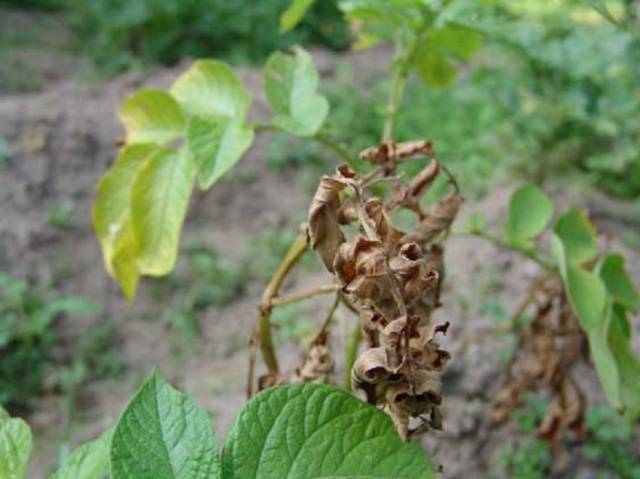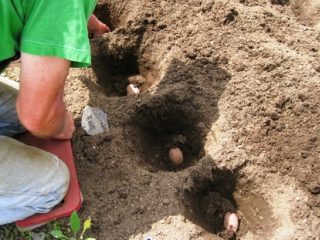Content
When growing potatoes, the main attention of gardeners is aimed at the formation of healthy and large tubers. This criterion ensures a high-quality harvest. Potato tops does not have the same value, but is used in folk medicine in the preparation of recipes and for pest control in the garden. But by its appearance one can judge the condition of the tubers and the entire plant as a whole.
Gardeners often notice that in their beds dries or the potato tops turn black.
At the end of the growing season, before harvesting, the leaves still begin to dry out. But if this happens much earlier, then the reason for the appearance of black tops is the presence of a disease. It’s as if the lush green foliage is being replaced, it becomes dried out and turns black.
Which potato diseases cause this symptom and what to do to save the crop?
Reasons for the appearance of black tops
Most often, such changes occur with potato tops when bushes are affected by late blight.
Almost all regions are susceptible to the spread of this disease in garden beds. The damage affects not only the leaves, but also all parts of the plant. Therefore, the struggle takes a lot of effort and time. It is better to prevent late blight in the garden than to fight it. It refers to fungal diseases that spread at high speed.This is where its greatest danger lies. If measures are not taken in time, the fungus will affect all plantings. In addition to the fact that the tops of potatoes affected late blight, becomes black, its tubers rot badly during storage.
How does this dangerous disease manifest itself on potato tops? At the beginning of the disease, the leaves become covered with small brown spots, which then turn brown and become dark brown. The affected tops dry out and fall off. Why are potatoes affected by late blight?
The source of the disease is:
- uncollected plant residues;
- planting material infected with fungus;
- violations of agricultural technology requirements when growing potatoes.
The more potatoes are planted, the more difficult it is to stop the spread of the disease, which causes the tops to turn black. The most favorable time for late blight to begin to spread is considered to be the moment the bush blooms. Although the timing of the appearance of the phytopathogenic fungus depends on weather fluctuations. Very rapid spread occurs during humid, warm days - these are optimal conditions for the development of the disease.
The lesions are most noticeable on old potato varieties, which are treasured by experienced gardeners. They do not always have increased resistance to late blight. Then the disease spreads to other types of potatoes on the site.
Late blight in potatoes begins with the tops. The leaves appear burnt, quickly turn black and dry out. A severe degree of damage leads to the death of the entire bush. When watering or raining, pathogenic microflora with drops of water are transferred to the tubers. Their growth stops, then they begin to rot. The danger of late blight also lies in the fact that it entails the occurrence of other diseases in potatoes.Plant immunity is reduced, and they easily succumb to other fungal infections or wet rot.
With high humidity and an air temperature of at least 15°C, late blight develops very rapidly and can affect plantings in a matter of hours. This happens especially quickly during potato budding and flowering.
Another reason for the spread of the disease and the appearance of black leaves on potato bushes is violation of agricultural cultivation techniques.
Among the main mistakes gardeners make are:
- Covering dug up potato tubers with tops. If the leaves are affected, the disease quickly spreads to the tubers.
- Failure to meet harvest deadlines. They try to dig up early varieties later so that the peel becomes denser. But at this time the autumn rains are already beginning. Drops of water wash away fungal spores and transfer them to the soil. Tubers become infected.
Potato tops may turn black if infected with another fungal disease - "black leg" In this case, the disease factors will be high humidity and low air temperature. The soil becomes damp and cold, which leads to the rapid spread of blackleg.
How to keep potato tops green
The best way is prevention and compliance with all agricultural technology requirements. If you nevertheless allow late blight to spread in a potato bed, then:
- Change planting material. Young shoots from infected tubers will already show signs of the disease.
- Change where you plant the potatoes. On contaminated soil, even healthy tubers will immediately become sick.But if the beds are well ventilated and other conditions for the development of the fungus are not allowed, then mass destruction can be avoided.
Preventive measures will be:
- liming of acidic soil;
- compliance with crop rotation;
- sowing green manure;
- isolation of potato beds from planting tomatoes, eggplants, physalis or peppers;
- selection of varieties resistant to late blight;
- proper application of fertilizers and wood ash during planting;
- spraying bushes with copper-containing compounds 2 weeks after germination;
- spraying the tops before budding with the preparations “Hom” and “Oxyx”.
What to do if the potato tops have already turned black
In this case, it is necessary to rhythmically spray the bushes with Bordeaux mixture and copper oxychloride at intervals of 7-10 days.
The main attention is paid to the leaves of the plant, which are processed on both sides. A heavily blackened bush is destroyed.
In addition, it is necessary mow and burn all affected tops a week before harvesting. The harvested tubers are provided with good aeration and an air temperature of plus 10°C - 18°C. After 3 weeks, the harvesting is repeated.
It is quite possible to prevent late blight from entering your area. Therefore, pay enough attention to preventive measures and your potato tops will be saved from blackening.












